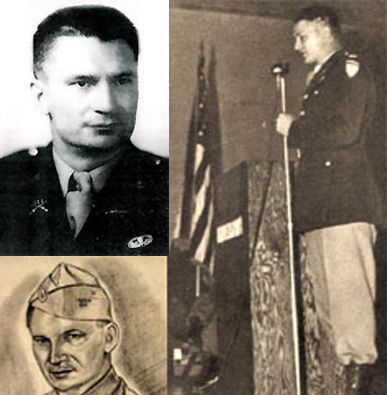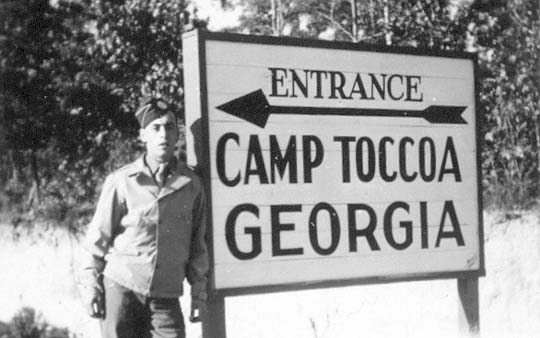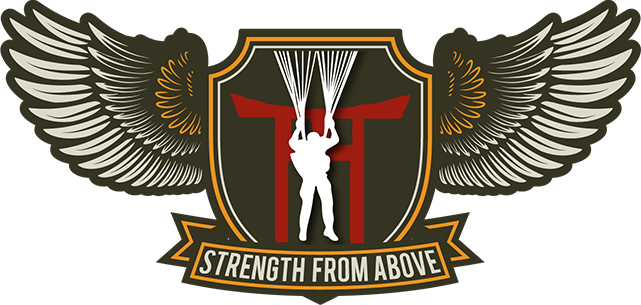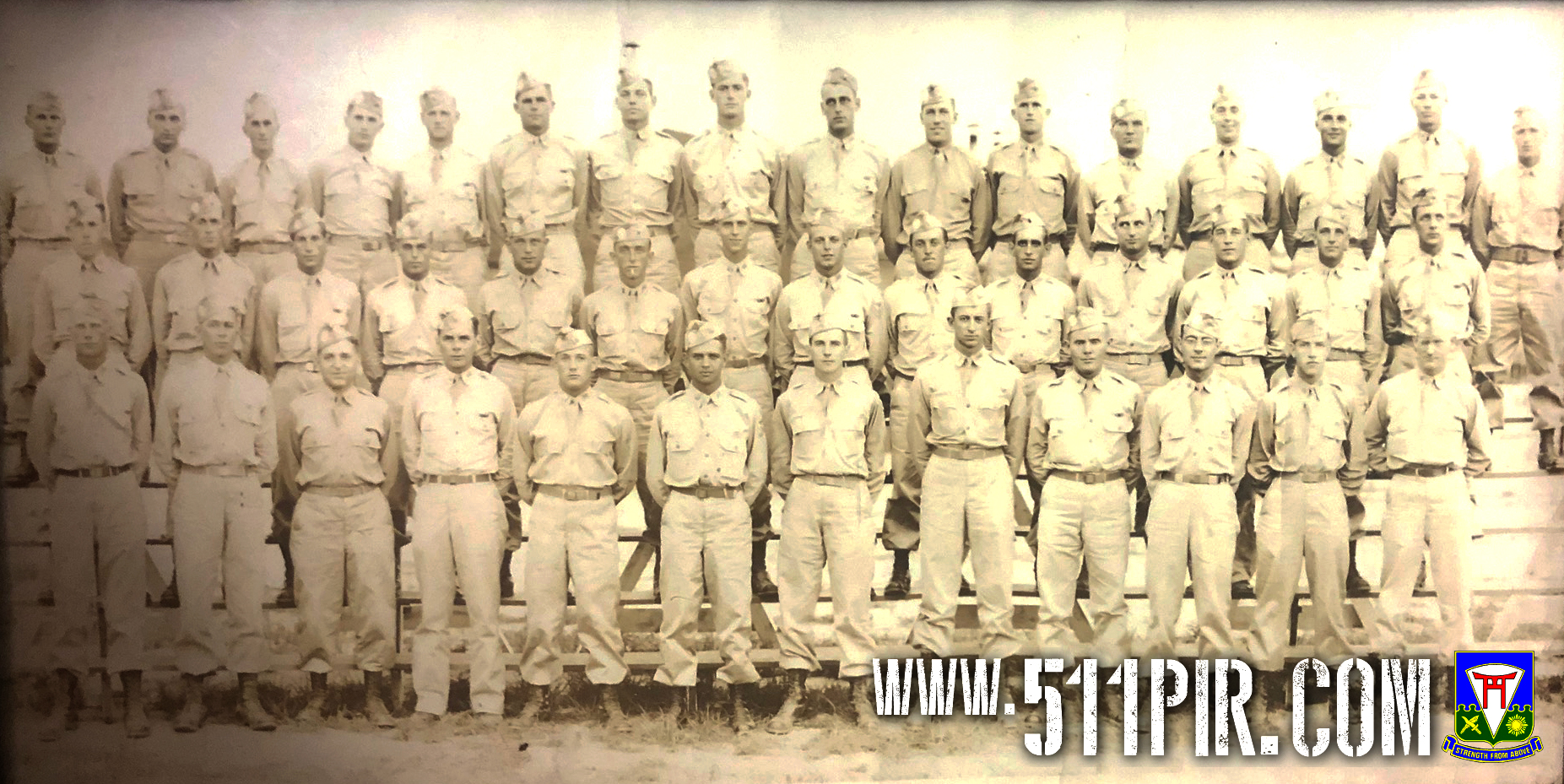Stateside / Training
Down From Heaven: The 11th Airborne Division Band
 While the mighty 11th Airborne Division served with distinction in World War II and Korea, the division's "theme song" did not come along until the fall of 1950 after the Angels had returned to the United States following Occupation Duty in Japan. A contest was held to encourage the composition of songs and marches that would become anthems of the 11th Airborne Division and perhaps none of the final four entries is as well-known as the marching-ballad (which I'm sure was sung in bars and pubs by Angels since 1950) titled "Down From Heaven", an original song submitted by Colonel Byron Leslie Paige (SSN 376405509, USMA 1932) of Shelby, Michigan. The music that accompanied COL Paige's lyrics was arranged by Sergeant George Whissen.
While the mighty 11th Airborne Division served with distinction in World War II and Korea, the division's "theme song" did not come along until the fall of 1950 after the Angels had returned to the United States following Occupation Duty in Japan. A contest was held to encourage the composition of songs and marches that would become anthems of the 11th Airborne Division and perhaps none of the final four entries is as well-known as the marching-ballad (which I'm sure was sung in bars and pubs by Angels since 1950) titled "Down From Heaven", an original song submitted by Colonel Byron Leslie Paige (SSN 376405509, USMA 1932) of Shelby, Michigan. The music that accompanied COL Paige's lyrics was arranged by Sergeant George Whissen.
Apart from the actual words of the song, the musical component of COL Paige's piece has been lost to history until now. For several decades the division's "old troopers" and a handful of interested historians have had access to the song's words, but I recently came across one of the last (as far as I can tell) recordings of this rousing song on an old vinyl LP recorded by the 11th Airborne Division Band with the 188th Airborne Infantry Regiment Choral Group under W.O. Carroll H. Grummish. Recorded at Reavis Recording Company (2014 Beech Avenue, Nashville, Tennessee), this old record from 1950 was a bit scratchy and dusty, and after several hours of labor I have done my best to digitize and clean up the audio. If you would like a copy of this song, please email me using this website's contact form. -Jeremy Holm
You can listen to the cleaned up copyrighted audio of this song by clicking below. The words of the song are below the player and then a brief history of the 11th Airborne Division Band follows. NOTE: there is also a bonus song titled "Luzon March" that was recorded at the same time in 1950 by the 11th Airborne Division Band and was composed by band-member and future MTNA-fellows Paul Bordeleau of Bedford, New Hampshire.
"Down From Heaven"
BONUS TRACK: "Luzon March"
Who Was Colonel Orin D. "Hard Rock" Haugen? Part 2
 This is Part 2 of our series on the legendary Colonel Orin D. "Hard Rock" Haugen #18254. You can read "Part 1: Who Was Colonel Orin D. "Hard Rock" Haugen?" by clicking here.
This is Part 2 of our series on the legendary Colonel Orin D. "Hard Rock" Haugen #18254. You can read "Part 1: Who Was Colonel Orin D. "Hard Rock" Haugen?" by clicking here.
While there is an unfortunate scarcity of research out there in regards to the 511th Parachute Infantry Regiment, and the 11th Airborne Division to which the 511th PIR belonged, there has been even less written or documented regarding the men who fought as Angels in World War II. While the 511th PIR served under two leaders during the war whom were greatly revered, the man who laid the foundation for the regiment's historic achievements was given an appropriate nickname for such accomplishments: Hard Rock.
Camp Mackall
Four days after Colonel Orin D. Haugen's 511th Parachute Infantry Regiment closed on North Carolina's Camp Mackall in March of 1943, they became the first fully-formed unit of Major-General Swing, Joseph May's new 11th Airborne Division, the first unit to headquartered at the new camp.
Opened just six weeks prior to the 511th’s arrival, the 56,000-acre post (a sub-installation of Fort Bragg) was originally named Camp Hoffman after the nearby rail station. On February 8, the War Department issued General Order Number 6 renaming the post after Private John T. Mackall, a paratrooper from the 503rd PIR killed by strafing Vichy French fighters during Operation Torch (John was wounded on November 8, the same day construction on the camp began, then died three days later).
When Colonel Haugen’s regiment arrived at Mackall, they found their new beds spotlessly made by the barrack’s previous tenants, the 82nd Airborne’s 504 and 505 PIRs. The luxuries did not last as Hard Rock ordered their clean, white sheets replaced with rough wool blankets. His paratroopers thought the actions harsh until they discovered that their small coal-fed heaters were less-than-adequate against the night’s chill (those bunking far from the stoves stoked them red hot at night which singed the eyebrows of the closer men).
Haugen’s young regiment was joined at Mackall by the 457th Parachute Field Artillery Battalion and the 187th and 188th Glider Infantry Regiments. Of the original 12,000 men who volunteered for the 511th, only 2,176 remained (2,000 enlisted, 173 officers and three warrant officers). Camp Toccoa’s endless PT, Haugen's enthusiastically-supported brutal runs on Currahee, the mock jump towers, and Hard Rock's demands for excellence had eliminated nearly 10,000 men who did not meet the Colonel's standards.
And yet, unlike their Commanding Officer, most of the men were not yet paratroopers and while they could wear parachutist patches on their garrison caps, they had yet to earn their jump wings. That was about to change. While Colonel Haugen's cadre fought to select who would serve as their NCOs and in their squads, Hard Rock decided to give his regiment one final test before jump school. Orin ordered a two-week bivouac maneuver that included a twenty-five-mile march out to the mission area where the 511th lived in pup tents and participated in several combat simulations and problems. The last night was spent hiking the twenty-five miles back to Mackall in full kits.
Averaging five miles an hour, the men were told that if they fell out, they would be transferred. Given that many were suffering from dysentery at the time, the march was doubly challenging, yet the regiment finished Haugen’s exam. When the column passed through Mackall’s gates and turned into the 511th’s area, Col. Haugen and his staff stood proudly outside RHQ where Hard Rock loudly proclaimed his congratulations for a job well done.
“It almost made it worthwhile!” commented D Company’s new Company Mail Orderly Cpl. Murray Hale, reminding us of Orin's penchant for withholding praise. Not because he didn't care or was oblivious to his men's accomplishments, but rather because it just wasn't his style.
After three additional months of training under Haugen's watchful eye, the 511th changed locale once more and this time his men felt greater anticipation.
“We were on a high all the time,” Private First Class Billy Pettit explained.
On May 14, Orin's regiment loaded into trucks for the six-hour trip to Fort Benning’s parachute school.
Second Battalion Officers' Photo
Officers of 2nd Battalion
1943
511 Parachute Infantry
Camp McCall
Note: Click photo to enlarge. McCall mispelling above is on original photo. All names listed are from the photo's left to right and units are listed at time photo was taken
Row 1:
1LT Lemuel T. Pitts (E Co); 1LT Edwin B. Jeffrees Sr. (F Co); Capt. Matthew Platt, MD (Battalion surgeon / 511th Medical Detachment); 1LT John W. Norwalk (F Co); Capt. Charles E. "Baldy" Jenkins (CO HQ2); Maj. Wallace L. Chambers (Regimental surgeon / CO 511th Medical Detachment); LTC Norman Shipley (CO 2nd Battalion); Capt. Lyman S. Faulkner (CO D Co); Capt. Hobert B. Wade (CO E Co); ? Rath; ? Marshall; 1LT C. A. Disney (HQ2).
Row 2:
2LT Randolph W. Kirkland (HQ2); 2LT R. T. Alsbury (HQ2); 1LT I. N. Raphael (HQ2); 2LT Robert Norris (HQ2); 2LT R. O. Macey (HQ2); 2LT R. W. Buckholt (HQ2); 2LT W. Ackerman; 1LT A. Fred Renaud (E Co); 1LT Winfred H. Samuels (F Co); 2LT William J. Light (D Co); 2LT G. L. Abernathy (D Co); 2LT H. J. Reid (HQ2); 2LT R. R. Culberston; 2LT L. C. Hover.
Row 3:
2LT Ralph E. Ermantinger (F Co); 1LT Andrew Carrico (D Co); 2LT Ernest H. "Bud" Martin (F Co); 2Lt L. C. Manley (F Co); 1LT William E. Nellist (F Co); 1LT T. W. Brady (E Co); 1LT Patrick W. Wheeler (HQ2); 1LT Thomas A. Meserau (E Co); 2LT Glenn W. Freeman (F Co); ? Clark; 2LT Walter E. Kannelly (D Co); ? Moore; 1Lt Thomas P. Gannon (E Co); 2LT W. C. Joyner; 2LT Leo Crawford (HQ2); 1LT Francis P. Solomon (D Co).
Who Was Colonel Orin D. "Hard Rock" Haugen? Part 1
This is Part 1 of our series on the legendary Colonel Orin D. "Hard Rock" Haugen #18254. You can read "Part 2: Who Was Colonel Orin D. "Hard Rock" Haugen?" by clicking here.
 While there is an unfortunate scarcity of research out there in regards to the 511th Parachute Infantry Regiment, and the 11th Airborne Division to which the 511th PIR belonged, there has been even less written or documented regarding the men who fought as Angels in World War II. While the 511th PIR served under two leaders during the war whom were greatly revered, the man who laid the foundation for the regiment's historic achievements was given an appropriate nickname for such accomplishments: Hard Rock.
While there is an unfortunate scarcity of research out there in regards to the 511th Parachute Infantry Regiment, and the 11th Airborne Division to which the 511th PIR belonged, there has been even less written or documented regarding the men who fought as Angels in World War II. While the 511th PIR served under two leaders during the war whom were greatly revered, the man who laid the foundation for the regiment's historic achievements was given an appropriate nickname for such accomplishments: Hard Rock.
Early Years:
Orin Doughty Haugen (018254) was born on August 18, 1907 in Wyndmere, North Dakota, bringing the population at the time to around 570. Orin's health was poor for much of his developmental years and as such he became a target for school bullies who often picked on the future Angel. it was during these years that Orin decided he would never back down from a fight or run away in fear, an attribute he would instill in his paratroopers nearly two decades later.
West Point to Pearl Harbor
After high school Orin attended first St. Olaf's College in Northfield, MN then Cornell College in 1925 before, at age 19, he was appointed to the United States Military Academy at West Point on July 1, 1926 where he spent four years learning what it meant to be a good soldier and an exceptional leader. For reasons Orin never fully clarified publicly, he hated his time at West Point, but he was dedicated to his pursuit and applied himself fully to the task. As such, Cadet Haugen graduated 3rd in his class with a Bachelor's of Science degree and was commissioned a 2nd Lieutenant in the Infantry on June 12, 1930.
His first posting was to historic Fort Snelling at the confluence of the Mississippi and Minnesota rivers, an assignment that was made considerably brighter when he met Minneapolis-native Marion Sargent who was the daughter of Dr. and Mrs. W. E. Sargent. After the two were married in a happy, but modest celebration on June 1, 1931, Marion dutifully accepted the life of a "soldier's wife". The young couple shared many adventures and common interests together, including horse back riding which the two were quite proficient at. In fact, the Haugens appeared in several horse shows around the Twin Cities area and Marion's horse "Whiskey" has a prominent burial site at Fort Snelling.
 By this time Orin had also become quite proficient in polo and over the course of the ensuing years would travel intermittently to play and compete for the Army. He also continued his passion for running, a habit he formed while running cross-country at West Point and one that would heavily influence the training of his future 511th Parachute Infantry Regiment (much to the men's dismay).
By this time Orin had also become quite proficient in polo and over the course of the ensuing years would travel intermittently to play and compete for the Army. He also continued his passion for running, a habit he formed while running cross-country at West Point and one that would heavily influence the training of his future 511th Parachute Infantry Regiment (much to the men's dismay).
It was somewhere around this time that, ironically, the athletic Haugen started smoking cigarettes, a habit that was common at the time and would lead to several officers who served with Orin to label him a definitive "chain smoker." In fact, when fighting alongside the paratroopers of his 511th PIR in the mountains of Leyte in late 1944, Haugen was seen searching for cigarette butts to spear with a stick to get one final puff.

Camp Toccoa & the 511th PIR
 With America officially at war, in 1942 the country's military leadership began to accelerate the training of their still very new parachute troops. And Camp Toccoa, Georgia, now made famous by the HBO miniseries "Band of Brothers", played an important role in that effort.
With America officially at war, in 1942 the country's military leadership began to accelerate the training of their still very new parachute troops. And Camp Toccoa, Georgia, now made famous by the HBO miniseries "Band of Brothers", played an important role in that effort.
While Toccoa was, by comparison, a “little camp outside a little town far off the beaten path", over 18,000 young men and officers would train there and go on to fight overseas in northern AND southern France, in Holland, and at the Battle of the Bulge then "liberate" Hitler's Kehlsteinhaus, or Eagle's Nest, and then march down Pennsylvania Avenue after the war was over "over there".
At least, that is the limit to what most airborne enthusiasts and even some historians believe to be the case. Far too often the story of the 511th Parachute Infantry Regiment is overlooked or forgotten although it was the third of the four regiments (the 506th, 501st, 511th and 517th in that order) that formed at Camp Toccoa. Like all original Toccoa-men, the 511th cut its teeth (and "sweat blood") on the area's famous Currahee Mountain before, according to its future commander Colonel Edward H. Lahti, going on to create a "record unmatched in history".
But it is a record that most people know nothing about and it is of no surprise that my grandfather, 1st Lieutenant Andrew Carrico, III disliked most history books on the war since his beloved 511th PIR was hardly covered, if it was mentioned at all. His was a common sentiment among the "old troopers" of the 511th, and the 11th Airborne Division to which they belonged, a feeling of resentment they griped about at post-war regimental reunions for decades as attested to by my grandmother, Jane Carrico. Jane is a proud "Angelette" who became dear friends with many troopers and their wives and continues to champion the cause of the mighty 511th even after most of its men have made "the final jump."
With countless Hollywood movies, documentaries, television series, magazines articles, blog posts, podcasts and books dedicated to the 82nd (517th PIR), 101st (501st & 506th PIRs) and 17th Airborne Divisions (517th PIR), the question many 11th Airborne Division troopers painfully had for the remainder of their lives was: What about us?



